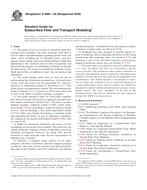Potřebujeme váš souhlas k využití jednotlivých dat, aby se vám mimo jiné mohly ukazovat informace týkající se vašich zájmů. Souhlas udělíte kliknutím na tlačítko „OK“.
ASTM D5880-95(2006)
Standard Guide for Subsurface Flow and Transport Modeling (Withdrawn 2015)
Automaticky přeložený název:
Standardní Průvodce pro podpovrchové Flow a modelování dopravy (Withdrawn 2015 )
NORMA vydána dne 1.7.2006
Informace o normě:
Označení normy: ASTM D5880-95(2006)
Poznámka: NEPLATNÁ
Datum vydání normy: 1.7.2006
Kód zboží: NS-32927
Počet stran: 6
Přibližná hmotnost: 18 g (0.04 liber)
Země: Americká technická norma
Kategorie: Technické normy ASTM
Anotace textu normy ASTM D5880-95(2006) :
Keywords:
computer model, groundwater, simulation: Computer model, Fluid-flow modeling, Ground-water model, Ground-water monitoring/sampling, Simulation testing, Subsurface investigation--soil/rock, ICS Number Code 13.060.10 (Water of natural resources)
Doplňující informace
| Significance and Use | ||||||||||||||||||||||||
|
Subsurface fluid flow modeling is a well established tool that can aid in studying and solving soil and groundwater problems. Evaluation of more complex problems has been allowed as a result of advances in computing power and numerical analysis, yet confusion and misunderstanding over application of models still exists. As a result, some inappropriate use occurs and some problems which could be readily addressed are not. The purposes of this guide are to introduce the basic concepts of subsurface fluids modeling and to show how models are described and categorized. This guide should be used by practicing groundwater modelers, purchasers of modeling services, and by those wishing to understand modeling. |
||||||||||||||||||||||||
| 1. Scope | ||||||||||||||||||||||||
|
1.1 This guide covers an overview of subsurface fluid-flow (groundwater) modeling. The term subsurface fluid flow is used to reduce misunderstanding regarding groundwater, soil water, vapors including air in subsurface pores, and non-aqueous phase liquids. Increased understanding of fluid-flow phenomena is the combined result of field investigations and theoretical development of mathematical methods to describe the observations. The results are methods for modeling viscous fluids and air flow, in addition to water, that are practical and appropriate. 1.2 This guide includes many terms to assist the user in understanding the information presented here. A groundwater system (soils and water) may be represented by a physical, electrical, or mathematical model, as described in 6.4.3. This guide focuses on mathematical models. The term mathematical model is defined in 3.1.11; however, it will be most often used to refer to the subset of models requiring a computer. 1.3 This guide introduces topics for which other standards have been developed. The process of applying a groundwater flow model is described in Guide D5447. The process includes defining boundary conditions (Guide D5609), initial conditions (Guide D5610), performing a sensitivity analysis (Guide D5611), and documenting a flow model application (Guide D5718). Other steps include developing a conceptual model and calibrating the model. As part of calibration, simulations are compared to site-specific information (Guide D5490), such as water levels. 1.4 Model use and misuse, limitations, and sources of error in modeling are discussed in this standard. This guide does not endorse particular computer software or algorithms used in the modeling investigation. However, this guide does provide references to some particular codes that are representative of different types of models. 1.5 Typically, a computer model consists of two parts; computer code that is sometimes called the computer program or software, and a data set that constitutes the input parameters that make up the boundary and initial conditions, and medium and fluid properties. A standard has been developed to address evaluation of model codes (see Practice E978). 1.6 Standards have been prepared to describe specific aspects of modeling, such as simulating subsurface air flow using groundwater flow modeling codes (see Guide D5719) and modeling as part of the risk-based corrective action process applied at petroleum release sites (see Practice E1739). 1.7 This guide offers an organized collection of information or a series of options and does not recommend a specific course of action. This document cannot replace education or experience and should be used in conjunction with professional judgment. Not all aspects of this guide may be applicable in all circumstances. This ASTM standard is not intended to represent or replace the standard of care by which the adequacy of a given professional service must be judged, nor should this document be applied without consideration of a project's many unique aspects. The word “Standard” in the title of this document means only that the document has been approved through the ASTM consensus process. |
||||||||||||||||||||||||
| 2. Referenced Documents | ||||||||||||||||||||||||
|
Odebírejte informace o nově vydaných normách ZDARMA:
Chcete pravidelně odebírat informace o nově vycházejících normách z celého světa a to zcela zdarma?
Přihlašte se k odběru. Vše je velice jednoduché a absolutně ZDARMA.
Na výběr máte vydavatele z celého světa.




 Cookies
Cookies
